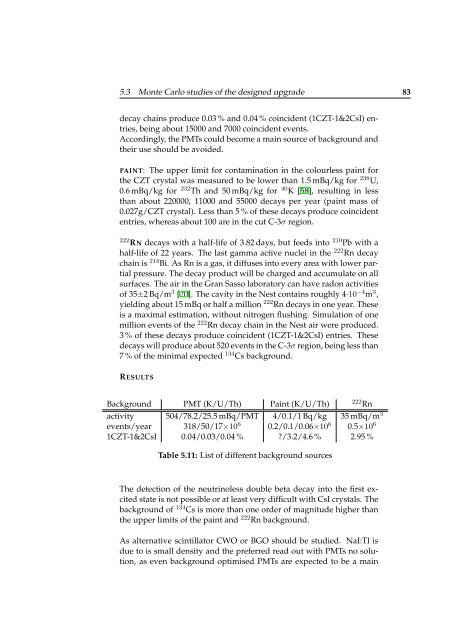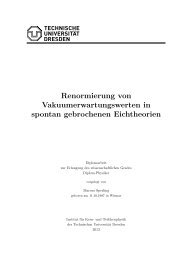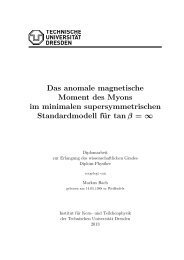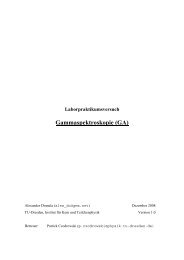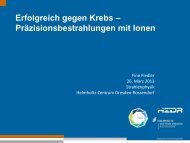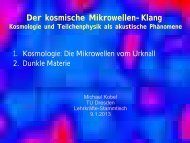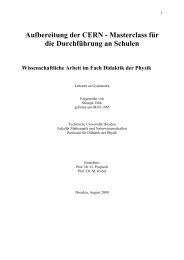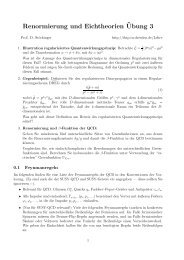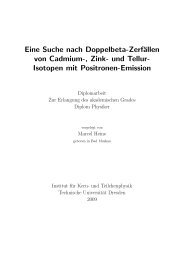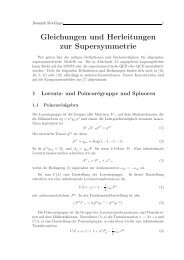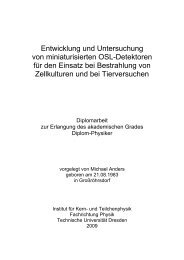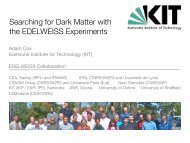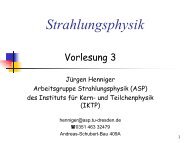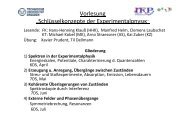a design study for a cobra upgrade to - Institut für Kern- und ...
a design study for a cobra upgrade to - Institut für Kern- und ...
a design study for a cobra upgrade to - Institut für Kern- und ...
You also want an ePaper? Increase the reach of your titles
YUMPU automatically turns print PDFs into web optimized ePapers that Google loves.
5.3 Monte Carlo studies of the <strong>design</strong>ed <strong>upgrade</strong> 83<br />
decay chains produce 0.03 % and 0.04 % coincident (1CZT-1&2CsI) entries,<br />
being about 15000 and 7000 coincident events.<br />
Accordingly, the PMTs could become a main source of backgro<strong>und</strong> and<br />
their use should be avoided.<br />
PAINT: The upper limit <strong>for</strong> contamination in the colourless paint <strong>for</strong><br />
the CZT crystal was measured <strong>to</strong> be lower than 1.5 mBq/kg <strong>for</strong> 238 U,<br />
0.6 mBq/kg <strong>for</strong> 232 Th and 50 mBq/kg <strong>for</strong> 40 K [58], resulting in less<br />
than about 220000, 11000 and 55000 decays per year (paint mass of<br />
0.027g/CZT crystal). Less than 5 % of these decays produce coincident<br />
entries, whereas about 100 are in the cut C-3σ region.<br />
222 RN decays with a half-life of 3.82 days, but feeds in<strong>to</strong> 210 Pb with a<br />
half-life of 22 years. The last gamma active nuclei in the 222 Rn decay<br />
chain is 214 Bi. As Rn is a gas, it diffuses in<strong>to</strong> every area with lower partial<br />
pressure. The decay product will be charged and accumulate on all<br />
surfaces. The air in the Gran Sasso labora<strong>to</strong>ry can have radon activities<br />
of 35±2 Bq/m 3 [20]. The cavity in the Nest contains roughly 4·10 −4 m 3 ,<br />
yielding about 15 mBq or half a million 222 Rn decays in one year. These<br />
is a maximal estimation, without nitrogen flushing. Simulation of one<br />
million events of the 222 Rn decay chain in the Nest air were produced.<br />
3 % of these decays produce coincident (1CZT-1&2CsI) entries. These<br />
decays will produce about 520 events in the C-3σ region, being less than<br />
7 % of the minimal expected 134 Cs backgro<strong>und</strong>.<br />
RESULTS<br />
Backgro<strong>und</strong> PMT (K/U/Th) Paint (K/U/Th) 222 Rn<br />
activity 504/78.2/25.5 mBq/PMT 4/0.1/1 Bq/kg 35 mBq/m 3<br />
events/year 318/50/17×10 6 0.2/0.1/0.06×10 6 0.5×10 6<br />
1CZT-1&2CsI 0.04/0.03/0.04 % ?/3.2/4.6 % 2.95 %<br />
Table 5.11: List of different backgro<strong>und</strong> sources<br />
The detection of the neutrinoless double beta decay in<strong>to</strong> the first excited<br />
state is not possible or at least very difficult with CsI crystals. The<br />
backgro<strong>und</strong> of 134 Cs is more than one order of magnitude higher than<br />
the upper limits of the paint and 222 Rn backgro<strong>und</strong>.<br />
As alternative scintilla<strong>to</strong>r CWO or BGO should be studied. NaI:Tl is<br />
due <strong>to</strong> is small density and the preferred read out with PMTs no solution,<br />
as even backgro<strong>und</strong> optimised PMTs are expected <strong>to</strong> be a main


